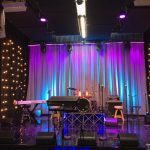By Ed Duncan
Going back to the early blues and dance clubs, bands took breaks to give the audience an opportunity to get drinks and drive revenue. I, like most, lived in the world that bands took breaks. It was all I knew since I had booked those clubs in the 70s where the owners wanted bands to take a break. As this took root, it became the norm and translated into the private party, festival and corporate sector. This strategy, as with many concepts, has outlived its usefulness.
Musicians over the years felt it was what all bands did, so they all did it. Many would take songs and try and stretch them out, so as to not have to play as many and then wait in the dressing room until someone came to get them to go back on stage after their break. Who else works 45 minutes and then takes a 15-minute break? Playing music may be less stressful compared to roofers who work in the hot sun for hours, a surgeon who may be on his feet 15 hours performing surgery or a bus driver who drives 12 hours to get you to a gig. If you want to succeed in today’s live performance marketplace, if you haven’t done it, it’s time for a new structure.
Fifteen years ago when I co-created Party On the Moon with Dennis Smith, one of the first prerequisites I had for agreeing to create the band was a 3-hour, non-stop show. Dennis thought I was crazy because he too had lived in a world where he always took breaks. Musicians were carefully selected with this important feature in mind to build the brand. Dennis regularly gets band leaders calling him about the 3-hour, non-stop format Party On The Moon uses for their shows. The first question is, “Why are you using this format?” The second question is, “How do you do it?”
The advantages to performing a non-stop show are obvious:
- With continuous music, the audience is fully engaged for the duration of the show. If you’ve done your job effectively, they will be screaming for more. Taking breaks suck the air our of the party and, like a train, you must slowly start it again.
- The band can structure the show for maximum impact, using momentum to create an unforgettable performance. This structure is far superior to the old model of taking breaks – which kills the energy of the performance. It takes more effort to jump start the energy of the room, than it does to keep the energy going.
So, “how do you do it?” There is no perfect answer. Each band is different. In most cases, your rhythm section never leaves the stage. The vocalists and horn section (assuming you have both ) leave the stage, but this is for blocking and set structure purposes. I have always said, “people hear with their eyes first, so use this to your advantage.” Giving the audience several different looks during the night keeps the visual aspect fresh, gives you the ability to do costume changes during the show and, most importantly, gives people a little break. As your band works with this new structure, you figure it out over time. It may be difficult at first. Just stay with it. You may have to make changes in your song list or change your line up. Be open to the process.
Remember – you’re creating a performance, not simply playing a list of songs. When you’re creating, you should have more energy when you finish than when you started. This is true with the artist, as well as the audience. Once you start to work with this structure, trust me, you will never go back.
This past New Year’s Eve, Party On The Moon performed a 4-hour-and-50-minute show for President Trump. They’ve done this for eight years. President Trump’s team has already made the call – they want Party On The Moon back next year. There is no question in my mind that going to the non-stop format has played a key roll in their bands success.
If your band is performing non-stop – good for you! If you’re on the sidelines thinking about it, remember, it is one of the best selling points for all the bands who now do it. Don’t be left behind!



